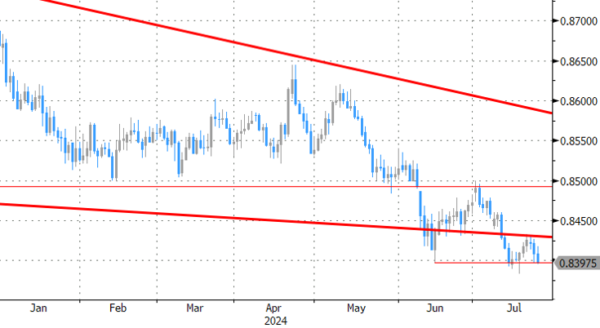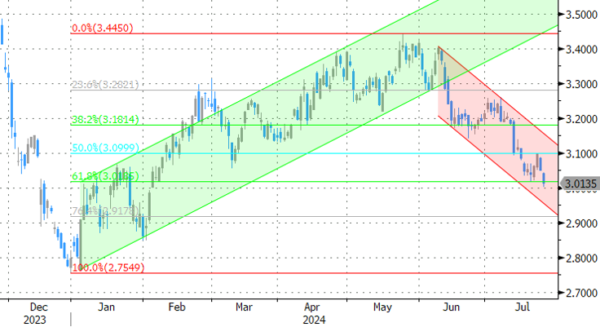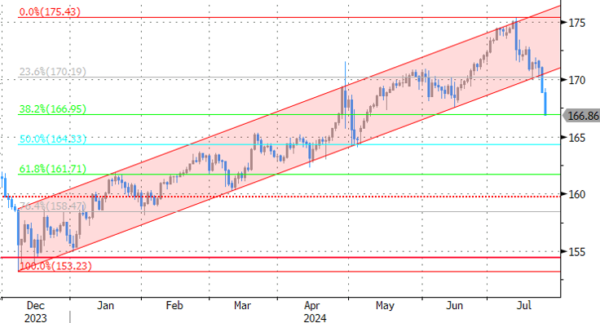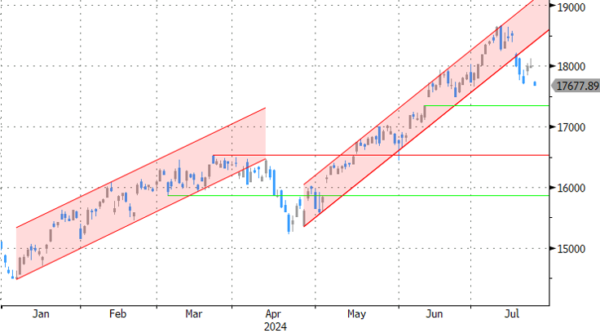Markets
Monthly PMI’s were the headline story on global markets. EMU surveys at least were no happy reading. The composite EMU HCOB PMI declined from 50.9 to 50.1 suggesting an near standstill in activity. The decline was mainly driven by a deepening contraction in German manufacturing (42.6). France also stays in sub-50 territory (composite 49.5), but improved. The EMU manufacturing index dropped further (45.6 from 45.8, 7 month low). This was still compensated by growth in services but momentum waned with growth at the slowest level in 4 months. (composite 51.9 from 52.8). According to S&P/HCOB “New orders fell for the second month running and business confidence dropped to a six[1]month low, leading firms to halt a spell of hiring which began at the start of 2024.” Subdued activity for now doesn’t translate into a congruent easing of price pressures. Input prices even increased sharply, especially in services but also manufacturing costs picked up. Output prices increased at a softer pace as weak demand limited company’s pricing power. This stagflationary message doesn’t make things easier as the ECB assesses the option of a next 25 bps cut for September. Still, the German yield curve steepens further (2-y -4.5 bps 30-y +1.0 bp). Despite persistent cost pressures, markets almost fully discount two additional 25 bps ECB cuts (September/December). The 2-y EMU swap yield almost touched the 3.0% barrier. European equities opened in red after disappointing earnings from some US bellwethers yesterday, dropped further after the PMI’s, but currently trade off the intraday lows (Eurostoxx 50 -1.0%). The euro shows a similar pattern touching a short-term low near 1.0826 after the PMI’s, but reversing of the full intra-day loss (EUR/USD 1.086).
Elsewhere, the UK activity performed better than its European counterpart with activity improving and prices tentatively slowing (cf infra). It doesn’t provide a clear signal going into next week’s BoE meeting. Short-term UK yields decline less than in the US and EMU (2-y -2.0 bps). EUR/GBP is again testing the 0.84/0.8383 support area. US yields in the meantime follow the broader steepening move (3-y -6 bps; 30-y +1.0 bp, 2-y decline of 8 bps contains benchmark change). In the meantime, lower short-term yields in the US and EMU further fuel an impressive comeback of the yen (USD/JPY 153.9 from 155.6, EUR/JPY 167.1 from 168.9). US PMI’s (published at the time of finishing this report) show a mixed picture. The composite index improved to a strong 55.0, including a contraction in manufacturing (49.6 from 51.6) but an improvement in services (56 from 55.3). A first market reaction stays limited.
News & Views
UK PMIs parted ways with the European ones, showing business confidence improved in July. The composite gauged rose from 52.3 to 52.7. The manufacturing sector posted the sharper increase in activity, catching up with stronger order book volumes and reducing outstanding workloads. Services activity picked up more moderately from 52.1 to 52.4 due to a faster increase in new work. This influx is attributed to improved market confidence and the securing of new contracts, which took a breather prior to the general elections. Staffing numbers rose at a fastest rate in over a year. Manufacturing input prices (especially those for transport thanks to the Red Sea crisis) rose sharply but were more than offset by an opposing trend in services (lowest in 41 months). Prices charged slowed to its weakest since February 2021, driven by a softer increase at service companies, but the pace stayed above its long-run trend. To finish it off, UK business confidence for the year ahead rebounded from a six-month low to a level just below the two-year high seen in February with the prospect of rate cuts, improving demand conditions and political stability cited as key reasons.
People familiar with the Bank of Japan’s thinking in a Reuters scoop today said the outcome of next week’s policy meeting is far less certain than consensus currently expects. In a Reuters poll about 75% expects the BoJ to stand pat but the sources said that the decision is a much closer call, labelling it is a judgment call in terms of whether to act now or later this year. Above-target (but not at all runaway) inflation lies in the balance with weak household sentiment and uncertainty over the outlook. At next week’s meeting, the BoJ is also poised to release details on how it is going to taper bond purchases (currently JPY 6tn per month). The sources said the central bank will probably follow the dominant market view to avoid unwelcome volatility. Based on a broad market inquiry last week, it may end up halving the monthly pace in 1.5 to 2 years time.
Graphs
EUR/GBP: divergent PMI performance between UK and EMU triggers new test of key 0.84/0.8383 support area.
EMU 2-y swap nears 3.0% barrier as markets expect poor growth to force the ECB to extend its easing cycle.
EUR/JPY: yen extends impressive comeback as ST core yields decline and BOJ is seen nearing further tightening.
Nasdaq: market reaction to first results from Tech bellwethers suggets bar for further gains is high.


















